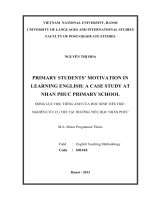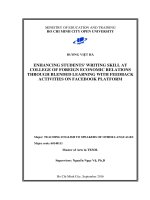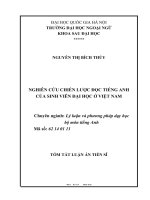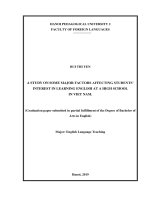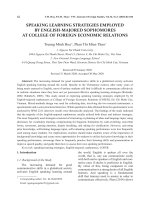RESEARCH ON STUDENTS’ MOTIVATION IN LEARNING ENGLISH AT COLLEGE OF FOREIGN ECONOMIC RELATIONS Nghiên cứu động lực học tiếng Anh của sinh viên trường Cao đẳng Kinh tế đối ngoại
Bạn đang xem bản rút gọn của tài liệu. Xem và tải ngay bản đầy đủ của tài liệu tại đây (924.09 KB, 46 trang )
VIETNAM NATIONAL UNIVERSITY, HANOI
UNIVERSITY OF LANGUAGES AND INTERNATIONAL STUDIES
FACULTY OF POST-GRADUATE STUDIES
*********************
TRẦN TUẤN CƯỜNG
RESEARCH ON STUDENTS’ MOTIVATION IN LEARNING ENGLISH AT
COLLEGE OF FOREIGN ECONOMIC RELATIONS
Nghiên cứu động lực học tiếng Anh của sinh viên trường
Cao đẳng Kinh tế đối ngoại
M.A MINOR THESIS
FIELD: ENGLISH TEACHING METHODOLOGY
CODE: 60140111
HoChiMinh, 2014
VIETNAM NATIONAL UNIVERSITY, HANOI
UNIVERSITY OF LANGUAGES AND INTERNATIONAL STUDIES
FACULTY OF POST-GRADUATE STUDIES
*********************
TRẦN TUẤN CƯỜNG
RESEARCH ON STUDENTS’ MOTIVATION IN LEARNING ENGLISH AT
COLLEGE OF FOREIGN ECONOMIC RELATIONS
Nghiên cứu động lực học tiếng Anh của sinh viên trường
Cao đẳng Kinh tế đối ngoại
M.A MINOR THESIS
FIELD: ENGLISH TEACHING METHODOLOGY
CODE: 60140111
SUPERVISOR: VŨ THỊ PHƯƠNG ANH, PhD
HoChiMinh, 2014
i
DECLARATION OF AUTHORSHIP
I hereby certify that the research report I am submitting is entirely my own
original work except where otherwise indicated. I am aware of the University's
regulations concerning plagiarism, including those regulations concerning disciplinary
actions that may result from plagiarism. Any use of the works of any other author, in
any form, is properly acknowledged at their point of use.
Student's signature:_____________________________________________________
Name (in capitals): _____________________________________________________
Date of submission: ____________________________________________________
ii
ACKNOWLEDGEMENTS
First of all, I would like to express many thanks to University of Language and
Foreign Studies – VNU and the Faculty of Post Graduate that offer me a chance to do
the thesis.
My deepest gratitude is sent to Ms. Vu Thi Phuong Anh who conveyed all her
enthusiasm in instructing me and giving me vital help in all the time of carrying out the
research.
I would like to show my most sincere thanks to the Faculty of Foreign
Languages at College of Foreign Economic Relations for accepting my research and
assisting me.
I am deeply indebted to Ms. Tong Thi Thu Dung who helped me carry out the
survey in her classes. She also provided me with all necessary information about the
students and the course.
This thesis would not have been possible unless I had not received sincere
cooperation of the whole classes KT17A and KT17B who provided main source of
data for the thesis as well as had memorable time with me.
I engrave in my mind my beloved family‘s continuous encouragement which
brings up my motivation to overcome difficulties in my life and to reach to the peak of
success.
iii
ABSTRACT
English is assigned in the curricula at almost all colleges and universities in
Vietnam. In fact, Vietnam gains little success in ELT, especially at public schools. One
of the reasons for this unexpected fact is related to students‘ attitudes and motivation in
learning English. This is also the concern of the researcher who is teaching at College
of Foreign Economic Relations (COFER). The researcher will carry out a survey at his
institution to find out the answers for the question – What is COFER students‘
motivation level in learning English? 85 students in two classes of English 1 are
intended to participate in the survey. The researcher will gather data from
questionnaires and the final test of the subject English 1. The students‘ motivation in
learning English will be analyzed via the findings from questionnaires. Besides, the
researcher determines the relationship between students‘ motivation and their learning
achievement with the data from questionnaires and the test. The researcher hopes to
reveal the current situation related to students‘ motivation at his college in order to
complete his teaching job better.
Key words: motivation, acquisition, instrumental, integrative, achievement
iv
TABLE OF CONTENTS
DECLARATION OF AUTHORSHIP i
ACKNOWLEDGEMENTS ii
ABSTRACT iii
TABLE OF CONTENTS iv
DEFINITION OF TERMS vi
LIST OF ABBREVIATIONS vii
LIST OF TABLES AND FIGURES viii
PART A: INTRODUCTION
1. Rationale 1
2. Aim of the study 1
3. Research questions 1
4. Scope of the study 2
5. Methods 2
6. Design of the study 2
PART B: DEVELOPMENT
CHAPTER 1: LITERATURE REVIEW 4
1.1. Motivation 4
1.2 .Language learning motivation 5
1.2.1. Gardner‘s socioeducational model 5
1.2.2. Deci‘s self determination theory 7
1.3. Correlation between LLM and learning achievement 8
1.4. Previous studies about LLM and the correlation between LLM and learning
achievement 10
CHAPTER 2: METHODOLOGY 14
2.1. Participants and setting of the study 14
v
2.1.1. Participants 14
2.1.2. Setting of the study 14
2.2. Data collection 15
2.2.1. Data Collection instruments 15
2.2.2. Data collection procedures 15
2.2.3. Data analysis procedures 16
CHAPTER 3: FINDINGS AND DISCUSSION 18
3.1 COFER students‘ attitudes toward learning English 18
3.2 COFER students‘ motivation in learning English 18
3.2.1 Integrative motivation 21
3.2.1 Instrumental motivation 22
3.3. Correlation between the students‘ motivation and their learning achievement 23
3.3.1. The correlation in comparisons of motivated students and low-
motivated students 23
3.3.2. The correlation in comparisons of instrumentally-motivated students
and integratively-motivated ones 24
3.4. Pedagogical implication 24
PART C: CONCLUSION
1. Conclusions of the study 26
2. Limitations of the study 26
3. Suggestions of the study 26
REFERENCES 28
APPENDIX A 32
vi
DEFINITION OF TERMS
Attitude refers to an evaluative reaction to some referent or attitude object,
inferred on the basis of an individual‘s beliefs or opinions about the referent (Gardner,
1985).
Motivation means the combination of effort plus desire to achieve the goal of
learning the language which leads to a conscious decision to act, and which gives rise
to a period of sustained intellectual and/or physical effort in order to attain previous set
goals. In this study, motivation is classified into two types: Instrumental and integrative
motivation (Gardner & Lambert, 1972).
Instrumental motivation refers to a learner‘s desire to acquire a new language
for utilitarian reasons and to reflect the practical value and advantages of learning a
target language (Gardner & Lambert, 1959; Hudson, 2000).
Integrative motivation refers to a learner‘s desire to learn more about the
cultural community of the target language or to assimilate in the target community
(Gardner & Lambert, 1959; Norris-Holt, 2001).
vii
LIST OF ABBREVIATIONS
AMTB: Attitude/motivation test battery
COFER: College of Foreign Economic Relations
ELT: English language teaching
EFL: English as foreign language
IM: Intrinsic motivation
MS: Motivation Survey
L2: Second language
LLM: Language learning motivation
SLA: Second language acquisition
viii
LIST OF TABLES AND FIGURES
Figure 1: A simple representation of the socioeducational model 6
Figure 2: The students‘ integrative motivation components 21
Figure 3: The students‘ instrumental motivation components 22
Table 1: The students‘ attitudes toward learning English 18
Table 2: The students‘ motivation in learning English 19
Table 3: Student groups arranged by motivation type 20
Table 4: The comparison of the learning achievement of motivated students and low-
motivated students 23
Table 5: The comparison of the learning achievement of instrumentally-motivated
students and integratively-motivated students 24
ix
1
PART A: INTRODUCTION
1. Rationale
Motivation attracts a great deal of care in the researching field of the second
language acquisition. Motivation along with attitude is considered the affective factor
of intake which is decisive in language learning (Kumaravadivelu, 2006 30). The
researcher is really curious about the care. As a new teacher at College of Foreign
Economic Relations, he wants to understand his students more clearly, especially their
motivation to English. In his experience at other institutions, students‘ motivation to
English is very limited and the students at COFER are known as more hard working
learners in English subjects. He wants to check the assumption and hope the findings
will ease his teaching job at the college.
2. Aims of the study
The study is aimed to figure out the students‘ attitudes to learning English as a
part of motivation with the reference to the Gardner‘s theories (1985).
The researcher also aims to study the student‘s level of motivation in learning
English and their preferred motivation type.
The study is carried out in the hope of caculate the correlation between
motivation in general and the students‘ achievement and the correlation between
specific motivation types and the achievement.
3. Research Questions
The researcher investigates the issue through three research questions
3.1 What are COFER students‘ attitudes toward learning English?
3.2 What are the students‘ levels of motivation in learning English?
3.3 Is the students‘ motivation positively correlated with their learning achievement?
2
4. Scope of the study
The study is carried out with the participation of students at COFER who started
learning English at the college. The study does not investigate teachers‘ perception of
students‘ motivation and attitudes as well as methods to influence on the two constructs
of the study.
5. Methods
First, the study uses quantitative method with survey techniques to investigate
students‘ motivation in learning English. The questionnaire is adapted from previous
studies (Ahmet, 2008; Liu, 2007; Gardner, 1985; Clement et al 1994). Then, the writer
bases on the findings from questionnaires and the final results of the subject English 1
and figure out the correlation of the students‘ motivation and their learning
achievement.
6. Design of the study
The research report will be organized in three parts as follows:
Part A – INTRODUCTION – includes rationale, aims of the study, research
questions, scope of the study, methods, and design of the study
Part B – DEVELOPMENT – consists of three chapters:
Chapter 1 entitled LITERATURE REVIEW introduces theoretical
background of the study with the clarification of the constructs via relevant theories.
This chapter also reviews previous studies related to this research.
Chapter 2 named METHODOLOGY gives the information of
participants, setting of the study, and data collection and analysis tasks.
3
Chapter 3 – FINDINGS AND DISCUSSION – interprets the statistics
from data collected and figure out the hindering of the data to answer the research
questions.
Part C – CONCLUSION – summarizes the findings, states limitations of the
study and makes pedagogical recommendations to improve the situation after the
study.
4
PART B: DEVELOPMENT
CHAPTER 1: LITERATURE REVIEW
1.1. Motivation
No researchers deny the role of motivation in language, but they do not agree on
the exact definition of motivation (Oxford & Shearin, 1994 12). Researchers still do
not agree on its components and the different roles that these components play—
individual differences, situational differences, social and cultural factors, and
cognition (Renchler, 1992 15; Belmechri & Hummel, 1998).
At its beginnings the concept was examined and understood within a behavioural
framework in which behaviorists tried to understand ‗what moved a resting organism
into a state of activity‘, with heavy reliance on concepts such as instinct, drive, need,
energisation, and homeostasis (Weiner, 1990). It was considered too complex to
investigate directly, and many experimental researches conducted on animals were
applied to humans. It was clearly realized that the understanding of the concept was
not relevant to the education context.
Behavioral mechanical approaches to motivation became weak when the
cognitive revolution started in the sixties. In the period, Piaget laid down the cognitive
developmental theory in which motivation is perceived as ‗a built-in unconscious
striving towards more complex and differentiated development of the individual‘s
mental structures‘ (Oxford & Shearin, 1994 23). With the advance of the cognitive
approaches the field became more relevant to educational psychologists and the
cognitive shift led to concentration on the individual‘s role in his or her own
behaviour (Weiner, 1990). In other words, there has been a shift toward focusing on
why students choose to engage in academic tasks instead of focusing on what they do
5
and the time they spend doing so as has been the case with the behaviourist approach
(Rueda & Dembo, 1995). Concepts such as goal and level of aspiration, as well be
discussed below, replaced the unconscious concepts of drive, instinct and the like.
Individual differences were more highlighted with the introduction of
psychological concepts like anxiety, achievement needs and focus of control. More
cognitive concepts were developed during the seventies and eighties like self-efficacy,
learning helplessness and causal attributions.
1.2. Language learning motivation (LLM)
1.2.1. Gardner’s socioeducational model
The most influential model of LLM in the early sixties through the eighties of
the previous century was Socioeducational Model (Gardner, 1985). It was developed
by Gardner and following studies were carried out by him and associates. Gardner
defined motivation as a ‗combination of effort plus desire to achieve the goal of
learning the language plus favourable attitudes towards learning the language‘
(Gardner, 1985 10). In his model, Gardner talked about two kinds of motivation, the
integrative and the instrumental, with much emphasis on the former. The integrative
motivation refers to learners‘ desire to at least communicate or at most integrate (or
even assimilate) with the members of the target language. The instrumental
motivation refers to more functional reasons for learning the language such as getting
a better job, a higher salary or passing an examination (Gardner, 1985).
Of the two kinds of motivation, the integrative one was the core of Gardner‘s
model (Figure 1). The role of attitudes towards the learned language, its speakers and
the learning situation are all considered parts of the integrative motivation. In fact, the
integrative aspect of the model appears in three different components: integrative
orientation, integrativeness, and integrative motivation. According to Gardner (2001
10) orientations refers to the set of reasons for which an individual studies the
6
language; whereas, motivation refers to the driving force which involves expending
effort, expressing desire and feeling enjoyment. Besides, other understandings of the
concept of orientation have been suggested. For example, according to the
understanding of Belmsihri & Hammel (1998), and others in the field, orientations are
long-range goals, which, along with attitudes, sustain student‘s motivation.
Figure 1: A simple representation of the socioeducational model. Adopted from
Gardner (2001 12). The dotted square represents the borders of the integrative
motivation
7
1.2.2. Deci’s self determination theory
The self-determination theory is one of the most influential theories in
motivational psychology (Dornyei, 2003). According to the theory developed by Deci
and his associates, ‗to be self-determining means to experience a sense of choice in
initiating and regulating one's own actions‘ (Deci et al 1991 330). This is referred to as
autonomy. The theory distinguishes between two kinds of motivations: intrinsic and
extrinsic. The first refers to an individual‘s motivation to perform a particular activity
because of internal rewards such as joy, pleasure and satisfaction of curiosity.
Meanwhile, in extrinsic motivation the individual expects an extrinsic reward such as
good grades or praise from others. With the notion of autonomy and intrinsic
motivation, the self-determination theory offers a very interesting look at motivation
by setting a different agenda for language teachers. The theory laid its focus on how
people can create the conditions within which others can motivate themselves more
than on how people (e.g. teachers in the classroom) can motivate others.
Noels (2001), referring to Vallerand (as cited in Noels, 2001) and later works by
Vallerand and colleagues, classify the two types of motivations, within education, into
different categories. The intrinsic motivation (IM) could be one of three kinds: IM-
Knowledge (the pleasure of knowing new things), IM- Accomplishment (the pleasure
of accomplishing goals), and IM-Stimulation (the pleasure sensed when doing the
task). The extrinsic motivation has also been classified along a continuum of three
categories: external regulation, introjected regulation, and identified regulation (Deci &
Ryan, 2000 236). External regulation refers to actions that individuals pursue and that
are determined by sources that are external to the individual, such as tangible benefits
and costs. If learning the language is made for such an external incentive and this
incentive is removed, the activity of learning will halt. The second, less external
regulation, is introjected regulation, which refers to activities performed due to some
external pressure. An example is a person who learns the language in order not to feel
8
ashamed if he does not know it. Finally, individuals who possess identified regulation
are driven by personally relevant reasons, such as that the activity is important for
achieving a valued goal. Individuals who learn an L2 because they think it is important
for their educational development, for example, all fall within this category. Another
concept that is fundamental to the self-determination theory is the concept of
amotivation (Deci & Ryan, 2000 237). Amotivation, or learned helplessness, is the
situation in which people lack the intention to behave. They see no relation between the
efforts they make and the outcomes they get. This happens when they lack self efficacy
or a sense of control on the desired outcome. In this case, the learner has no goal and
thus possesses neither intrinsic nor extrinsic motivation to perform the activity (Noels,
2001).
1.3. Correlation between LLM and learning achievement
This research is based on Gardner‘s model (1985); therefore, the review of the
correlation focuses on the correlation of motivation types categorized by Gardner and
learning achievement.
As mentioned in the review of Gardner‘s socioeductional model, Gardner
introduced his motivation theory with the integrative motivation and instrumental
motivation. Of the two, integrative motivation is highly correlated with achievement,
so it has usually been held as superior (Crookes & Schmidt, 1991). This is not
necessarily Gardner‘s position since he states the social context might make an
instrumental orientation better in some situations and an integrative orientation better
in others (Williams, 1997). Au (cited in Crookes, & Schmidt, 1991 473) notes that the
theories related to integrative motivation, most of which imply its superiority, can be
summarized as five hypotheses:
1. The integrative motive hypothesis: an integrative motive will be positively
associated with SL achievement.
9
2. The cultural belief hypothesis: cultural beliefs influence the development
of the integrative motive and the degree to which integrativeness and
achievement are related.
3. The active learner hypothesis: integratively motivated learners are
successful because they are active learners.
4. The causality hypothesis: integrative motivation is a cause; SL
achievement, the effect.
5. The two-process hypothesis: aptitude and integrative motivation are
independent factors in second language learning.
‗Gardner‘s theories have influenced virtually all SL-related research in this
area‘ (Crookes & Schmidt, 1991 471), but have also been criticized, especially in
regard to the integrative motive hypothesis and the causality hypothesis. Interpretation
of the empirical data from research to validate these theories is controversial, since
various studies have produced different results. Clearly, other factors impinge. Some
factors, such as age, can be controlled for, but others, such as cultural values,
cannot. Gardner‘s chief critic, Oller, suggests that the relationship between affective
factors and language learning may be an ‗unstable non-linear function of high
variability‘ (Crookes & Schmidt, 1991 48).
In his 1988 defense of the theory, Gardner indicated that across a large number of
studies, there have been significant correlations between integrative attitudes and
language proficiency, and in his own later study (Gardner, 2001), he found a strong
correlation with the learning of vocabulary items. Integrative motivation has been also
correlated with persistence; Ramage (1991) conducted a study to find what relationship
exists between various motivations and the likelihood of a student to continue in a
program. She found that an interest in the foreign culture and in learning the
language, but not for instrumental reasons, thoroughly distinguished those students
who would continue in a program from those who would not.
10
The strong correlation between integrative motivation and achievement implies
causality, but, as in all correlations, making such an assumption is
speculative. Integrativeness and achievement might both be products of another, not
yet identified cause. Savignon and Strong (cited in Crookes & Schmidt, 1991 474),
have even proposed that the causality might work in reverse as well. Rather than a
positive attitude towards the target language leading to proficiency, proficiency and
success in the second language might cause a positive attitude, while failure produces a
negative attitude (Crookes & Schmidt, 1991).
Gardner has recently attempted to expand upon the original theory to include
other factors. His socio-educational model is ―operationally defined in terms of a
composite of variables including measures of integrativeness, attitudes towards the
learning situation, and motivation‖ (Gardner et al., 1992 198) but most scholars still
associate his name with the original dichotomy. Others, such as Clément, Dörnyei,
and Noels (1994), have concluded that integrative and instrumental orientations are
entwined rather than separate, and that to attempt to pose them as antithetical is
fruitless. Whatever the case, there is still a widespread agreement that integrativeness
is one of a number of factors closely tied to achievement and proficiency (Benson,
1991; Clément et al., 1994; Crookes & Schmidt, 1991; Gardner et al., 1992; Ramage,
1991; Skehan, 1991; Spolsky, 1988). Even in a context where foreign language
learning is largely an academic matter, student motivation remains socially
grounded.‖ (Clément et al., 1994 421).
1.4. Previous studies about LLM and the correlation between LLM and learning
achievement
Researches in this section supported the correlation between motivation and
success of language learner in second language acquisition (SLA). Krashen (2002)
hypothesizes the ‗affective filter‘ that consists of various psychological factors, such as
11
anxiety, motivation, and self-confidence, which can strongly enhance or inhibit second
language acquisition. An input rich environment is required where the learners can be
relaxed, motivated and self confident in acquiring the second language successfully.
Krashen (2002) contends that learners with high motivation, self-confidence, a good
self-image, and a low level of anxiety are well equipped for success in second language
acquisition. The correlation is slight in some studies and strong in others.
Masgoret and Gardner (2003) carried out a research to estimate the magnitude of
the contributions that motivation and attitudes make in the second language.
Integrativeness and attitudes toward the learning situation were two correlated
variables that supported the individual's motivation to learn a second language, but that
motivation was responsible for achievement in the second language. This
conceptualization implied that integrativeness and attitudes toward the learning
situation were related to achievement in the second language, but that their effect was
indirect, acting through motivation.
Liu (2007) investigated Chinese university students‘ attitudes towards and
motivation to learn English and the correlations of the said variables with the students‘
English proficiency. He modified the 44-item survey adapted from the Gardner‘s study
in the role of attitudes in 1985 and Clėment‘s study in motivation, self-confidence, and
group cohesion in the foreign language in 1994. 202 third-year non-English majors in
six classes of Xia‘men University in China participated in Liu‘s investigation. The
study revealed three findings. First, the students had positive attitudes and high
motivation in learning English. Second, the students were more instrumentally than
integratively motivated to learn English. Finally, the students‘ attitudes and motivation
were positively correlated with their English proficiency.
Humphreys and Spratt (2008) investigated Hong Kong tertiary students‘
motivation towards learning English, Putonghua and an elected language. The results
revealed that students learned Putonghua with more instrumental motivation. However,
12
English and the chosen language were more related to integrative motivation. One
important finding was that the students were aware of the instrumental value of
English, but the motive to learn English was not instrumental. The researchers
emphasized on integrative motivation as the key for teachers in Hong Kong to address
their students in learning English.
Hsu (2009) made a survey of business English learning motivation and effort on
proficiency among junior college students and found that ―the attitude, motivation and
effort in combination account for 19.5% of the variance of proficiency.‖ He concluded
that the most effective method to obtain higher proficiency in business English learning
is to increase students‘ motivation.
Wright and McGrory (2005) carried out a research on the motivational factor
causing the participants to enroll in an Irish class. They found that their participants
were integratively motivated, and their instrumental motivation for finding jobs was
not higher than their integrative motivation. They liked the sound of the language in
their daily lives. Peng‘s (2007) study on the relationship between willingness to
communicate in second language and integrative motivation showed that integrative
motivation was responsible for only a small proportion of variation in willingness to
communicate.
Phan and Le (2009) conducted an investigation into English learning motivation
of upper secondary school students in Quang Nam province, Vietnam. This study
investigated English learning goals and motivation and some factors influencing the
motivation of upper secondary students in Quang Nam. A modified 8-item survey
adapted from Gardener‘s AMTB and a 15 -possible demotivating factor survey were
administered to 100 upper secondary EFL students in four upper secondary schools in
Quang Nam. The study revealed that the students had positive attitudes toward learning
English and were highly motivated to study it, and that they were more instrumentally
than integratively motivated. Moreover, the students‘ motivation was more
13
demotivated by some subject-related factors rather than by teacher-related ones.
According to Gardner (2001), attitude to learned language is included to
integrative motivation. Thus, some researchers exploited the relationship between
attitudes toward learning foreign language and learning achievement. Investigating the
connection between attitudes and language learning in Hong Kong, Lai (1996)
withdrew a significant result when, ―The more they like English, the higher scores they
get, or vice versa; the more attentive they are in English classes, the higher marks they
get or the other way round.‖. Approving with Lai, Aydın and Zengin‘s research results
(as cited in Aydin, 2009) demonstrated that learners‘ beliefs, attitudes, expectations
and affective states exerted influence on the foreign language learning process.
Lamb (2007) carried out a twenty-month study on changes in students‘
motivation and learning activity. He found that initially the students had positive
attitudes toward learning the language but the attitudes gradually ruined over the period
of his study.
In conclusion, the correlation between motivation and learning achievement
exists through the studies above. Some studies found it weak while some supported it.
Metioned researchers also suggested ways to enhance students‘ motivation or their
learning achievement
14
CHAPTER 2: METHODOLOGY AND PROCEDURES
2.1. Participants and settings of the study
2.1.1. Participants
The writer conducted his survey on 85 freshmen majored in Accounting of
COFER. The students were in two classes KT17A and KT17B handled by his
colleague. At the time of research, the two classes were taking the course English 1.
The course book is Profile 1 for pre-intermediate level by Jon Nauton and Mark Tulip
published by Oxford University Press (2009). The course English 1 of three credits was
the first English subject for the students at the college. Before the subject, all the
students had to take an entrance English test of pre-intermediate level. The test was in
written form and focused on grammar, vocabulary, pronunciation, reading
comprehension and writing. All of them passed the test with the results over five.
2.1.2. Setting of the study
College of Foreign Economic Relations specializing in business majors has four
campuses including two in Phu Nhuan District, one in District 5, and the last in District
9, Ho Chi Minh City, Vietnam. The research was carried in the campus in District 5.
The participants are all at college level. The students learned English 1 in forty-five
periods at school. Each week they learned one four-hour section. After finishing the
course, the students continue their English learning with the subject English 2 at the
second semester and two more subjects English for Business Communication 1 and 2
as the criteria for their graduation.

